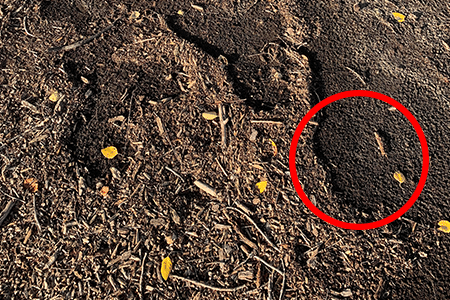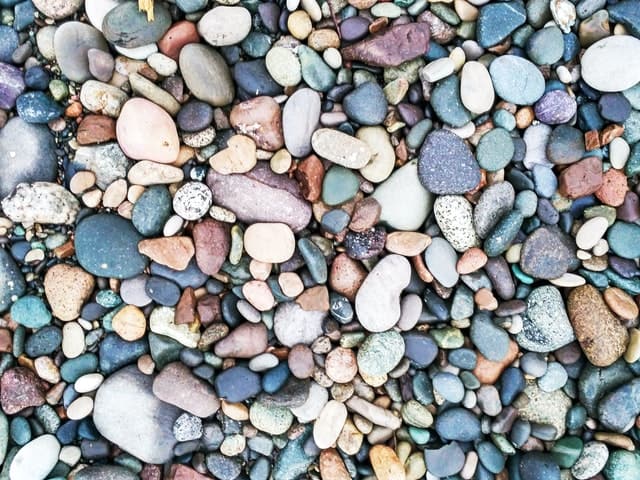There are a few things that rain can do to you and washing away your freshly placed mulch being one of them. Sometimes, you want to stroll into your garden with simplicity and not have to worry about mess and cleaning up the spoils of last night’s spell of rain! Read on to find out what to use to prevent mulch from washing away so you can put a stop to rain washing away your mulch

Table of Contents
Ideas to prevent mulch from washing away
There are many methods such as using netting, barriers and even meshes as you’ll see below for containing your mulch in your garden bed or garden.
Some are suitable for different scenarios so be sure to check out the pros and cons of each method.
Some being applicable on how to stop water from washing away mulch in general. Some more specific.
Use netting to stop mulch from washing away
When you lay down your mulch, a quick fix for stopping it becoming victim to the rain is to place netting over it and pin it down. Read up on our guide on mulch netting to find out all you need to know.
Did you know there are biodegradable types of netting and even types of bird netting you can use effectively for your mulch? You can really get creative.
Pros of using netting to stop mulch washing away
- Method is ideal if you are using mulch to protect seeds that have been freshly laid out so seeds can still grow through your netting.
- You can use thick netting instead of mulch like this one and stop weeds coming up while containing everything.
Cons of using netting to stop mulch washing away
- Netting can be expensive when used over a large area of land.
- If you use waterproof netting over a large area, it may lower the soil quality by making it hard to water. Undoing the work of mulch in the first place.
Use barriers to stop mulch from washing away
Barriers are an excellent way to stop the spilling of mulch in to other areas in your garden and will create a neat look.
Another name for it is mulch edging. Bury the edging partially underneath the soil to create a clear physical barrier.
This method will work in a similar way to raising the edges of garden beds. You are simply stopping the mulch from travelling vertically by using walls.
Barriers to stop mulch washing away include:
- Bricks
- Plastic edging
- Stones
- Tiles
- Bamboo
To install any of the edging materials listed simply plan out the border for your mulch and begin burying the material along the border so it is stable in the soil but still has a few inches above the soil to contain the mulch. Check out some DIY mulch edging ideas for inspiration.
Pros of using mulch barriers
- Perfect for separating different colours and shapes of mulch within the same area, creating a neat space.
- Can be done for free with old materials and even store bought mulch edging is relatively cheap.
- Aesthetically pleasing and unobtrusive to the rest of your garden and plants.
Cons of using mulch barriers
- Time consuming to set up and prone to being broken overtime.
- If you have light mulch that floats on the water surface, the mulch may still float over the water’s surface and wash away.
- Depending on the type of mulch, the mulch may still collect at the barriers of the mulch instead of staying in place. Essentially being washed around a contained area instead.
Use stones instead of other organic mulch
Instead of using the light mulch that is prone to washing away in a slight bit of rain, simply replace it with heavier mulch such as stones.

Pros of using heavy mulch
- Simple to install and can be placed over old mulch.
- Very effective and will not be washed away even in very heavy rain.
Cons of using heavy mulch
- May be time consuming or expensive to replace already bought mulch.
- Will have to manually remove the mulch when necessary as it will never biodegrade like other organic mulches.
Relocate mulch to drier, better drained areas
If you notice that there is an area of your outdoor space that has a lot of water often running over the surface and other areas with less.
Strategically place your growing areas and gardening beds in areas of low rain.
This is especially true if you have a gutter or drain pipe that throws off a lot of water.
Pros of relocating mulch
- Can solve the problem of mulch washing away for many years to come by simply moving your garden bed or growing area one time.
- Cost effective if you are able to plan out your growing space in advance.
- Drier, better drained soil may even have additional benefits to soil health like preventing anaerobic soil.
Cons of relocating mulch
- Very inconvenient if you already have most of your plants in the soil. The old saying prevails, prevention is better than cure!
Is double hammered mulch prone to washing away?
Typically, double hammered mulch is made of hardwood. Hardwood, as opposed to softwood is a type of tree that takes longer to grow, is denser in nature and is less likely to be moved by water.
So no, the mulch isn’t prone to washing away due to its material.
However, “double hammered mulch” gains its name because it is made of wood that has been hammered into smaller pieces twice and doesn’t have anything to do with the actual wood in the mulch
So for even better results, search around for hardwood single hammered mulch. This would come in even bigger pieces as it has been hammered less so would stick together during rain and wind more effectively.
Generally, the bigger the pieces in your mulch and , the less likely they are to move.


